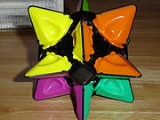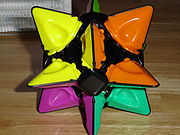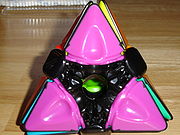
BrainTwist
Encyclopedia

Puzzle
A puzzle is a problem or enigma that tests the ingenuity of the solver. In a basic puzzle, one is intended to put together pieces in a logical way in order to come up with the desired solution...
designed and marketed by Chuck Hoberman
Chuck Hoberman
Chuck Hoberman is an inventor of folding toys and structures, most notably the Hoberman sphere. He won the Chrysler Design Award for Innovation and Design in 1997 and was a finalist for the 2000 Smithsonian National Design Award.-Creations:In addition to toys such as the Hoberman sphere,the...
's company Hoberman Designs. The puzzle is in the same family as the Rubik's Cube
Rubik's Cube
Rubik's Cube is a 3-D mechanical puzzle invented in 1974 by Hungarian sculptor and professor of architecture Ernő Rubik.Originally called the "Magic Cube", the puzzle was licensed by Rubik to be sold by Ideal Toy Corp. in 1980 and won the German Game of the Year special award for Best Puzzle that...
and other puzzles that involve manipulating and scrambling colored face elements with the goal of returning them to their original order from a randomized state, commonly called twisty puzzles. This puzzle is unique in that in addition to solving one set of tetrahedral faces the puzzle can be flipped inside-out through an intermediate stellated shape to reveal another (dual) tetrahedron
Tetrahedron
In geometry, a tetrahedron is a polyhedron composed of four triangular faces, three of which meet at each vertex. A regular tetrahedron is one in which the four triangles are regular, or "equilateral", and is one of the Platonic solids...
with a set of 4 different colored faces. The puzzle also has an alternate solution in which the apices are each a uniform color.
Basic elements
The BrainTwist consists of 12 colored triangular elements each with a notch to aid in turning the apices of the puzzle. There are eight colors in the puzzle: red, orange, yellow, light and dark green, blue, violet and magenta. Each of the 12 basic units has a unique combination of two of the colors - one per side. In the tetrahedral configuration each apex consists of 3 such elements. Each face of the tetrahedron is also composed of 3 basic color elements.Manipulation

By lifting the three elements of a face and bringing them towards each other, the entire puzzle opens up into the stellated form shown above. Continuing the "flip" move completely inverts the tetrahedron into its dual tetrahedron. The elements that were face elements now comprise the apices of the new tetrahedron and vice versa.
By performing arbitrary combinations of flips and rotations the pieces can be scrambled almost completely. The only restriction is that the mechanism prevents a 180 degree rotation of a piece so that the colors on the obverse and reverse of each piece never interchange. Consequently the two tetrahedrons are restricted to show only 4 of the eight colors at a time. There is a red-orange-violet-magenta (ROVM) tetrahedron and a yellow-blue-light green-dark green (YBLD) tetrahedron.
Solutions
A clue to solving a shuffled BrainTwist puzzle is to examine the stellated configuration. It is possible to solve for the ROVM tetrahedron while leaving the YBLD tetrahedron shuffled and vice versa. The only way to make sure the puzzle is completely solved is to check that the adjacent colors make sense in the stellated configurationThe puzzle is chiral
Chirality (mathematics)
In geometry, a figure is chiral if it is not identical to its mirror image, or, more precisely, if it cannot be mapped to its mirror image by rotations and translations alone. For example, a right shoe is different from a left shoe, and clockwise is different from counterclockwise.A chiral object...
: if one tries to build the faces one at a time then one might end up putting colors clockwise that should have been placed counterclockwise. The puzzle can only be solved if, for example, facing the Red face in stellated form the Blue, LightGreen, and Yellow faces proceed clockwise in that order (BLY). Sometimes this may not work.
There is an elegant algorithm to switch from the "faces" solution to the "corners" solution, or vice versa:
- Turn all corners 1 step clockwise
- Flip
- Turn all corners 1 step counterclockwise
- Flip
- Turn all corners 1 step clockwise
- Done

